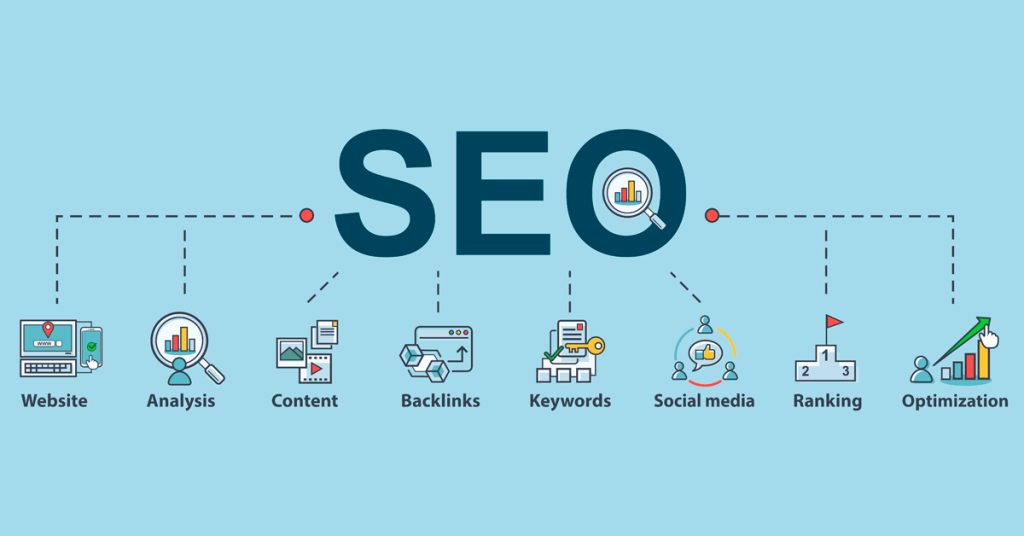Digital technologies make establishing an effective web presence vitally important to businesses of any size, regardless of industry. A functional website is key in drawing in visitors and leads, increasing revenue streams. This is where SEO growth strategies come into play.
Growing takes more than creating an eye-catching site. Growth SEO strategies must ensure your webpage ranks amongst the top results for visitors searching your keywords or phrases. In this article, we explore effective growth techniques that could increase visibility and performance on websites.

Start with a Strong Domain Name
The domain name you select is important for establishing your online identity. It also affects how search engines find and rank your website. The strength of a domain name can be determined by its length, how easy it is to remember, and whether the words within are related to what your business does or offers. Putting your main keyword into the domain name can also help with Growth SEO strategies because it makes clear what kind of site you have for search engines. But don’t overdo it by using too many keywords; this might look like spam and harm rankings.
Always conduct your domain name search on a reputable service provider. This way, you’re making sure you protect your domain name and put an extra layer of protection when it comes to cyberattacks.
Selecting a top-level domain extension such as .com is usually the best choice, as it’s the most familiar and relied upon by users. If your business is focused within one country, using a country-specific TLD like .uk or .ca can assist in improving local search rankings.
Optimize Your Website’s Structure and Navigation
A website that has a good structure and simple navigation is important for user experience as well as SEO. When search engines can easily crawl your site, they have more chances to index your content quickly and effectively. For this reason, make sure the structure of your website is easy to understand with a clear order, guiding users and search engines through it in an organized way.
First, arrange your content into logical categories and subcategories. Make sure that your URLs are descriptive and contain keywords to show the page’s content. For illustration, rather than using a URL such as “www.yoursite.com/page1,” go with “www.yoursite.com/seo-tips”. This doesn’t just strengthen SEO, it also makes the user experience better because people see what they can anticipate on every page.
A sitemap is a guide for search engines to find all the pages on your website. It makes sure that no content gets missed when they crawl or go through it. You might also think about putting in breadcrumbs. Breadcrumbs are like another way of moving around inside your site and they help people know where they are in relation to other parts of your website. Breadcrumbs also contribute to better internal linking, which is beneficial for SEO.
Create High-Quality, Keyword-Rich Content
It is very important to make good, keyword-filled content to get a better position on search engine results pages (SERPs). The content you create must be useful and interesting, focusing on what your intended audience needs. First, research keywords so that you find out the words or groups of words that people who could become your customers might look up in search engines. Use Google Keyword Planner, Ahrefs, or SEMrush to locate appropriate keywords that have high search counts and low competition.
When you have your focus keywords, it’s important to use them in a way that feels natural. As a general rule of thumb, use a keyword every 100-200 words. Put them into titles, headings, meta descriptions, and all parts of the text body but don’t stuff them as this may result in search engine penalties. Concentrate more on making content that gives your audience something valuable, respond to their inquiries, and fix issues.
Include multimedia elements like pictures, videos, and infographics in your content. These items are not only attractive but also offer more chances for optimization with alt text and descriptions. Regularly refresh your content because search engines prefer sites that always have new and suitable information available.
Depending on the industry, the type of content you create should align with the interests and needs of your target audience. For example, in recruitment and employer branding, creative retainers for careers websites ensure a steady flow of fresh, engaging content that keeps job seekers coming back. This approach not only improves SEO but also strengthens a company’s online presence, making it a go-to resource for career opportunities.
Build a Strong Backlink Profile
Backlinks are among the top elements that impact SEO. These function like recommendations or votes of confidence for your website, telling search engines it holds worth and can be trusted. But the quality of your backlinks is more important than how many you have. Getting backlinks from reliable, high-authority sites can greatly help improve your rankings in search engines.
Begin with producing content that others would like to link to. This might include detailed guides, unique investigations, or persuasive infographics. Outreach is crucial as well. Contact industry influencers, bloggers, and journalists who could be interested in your content and request them to link it. Also, you can write as a guest on well-known sites related to your field to get backlinks.
Checking your backlink profile is very important. It’s necessary to make sure that the links which are directed towards your site have good quality. You can do this by using tools such as Ahrefs or Moz. Alongside external backlinks, concentrate on constructing internal links within the pages of your website. This action assists in spreading page authority evenly and enhances navigation for users as well as search engines.

Leverage Technical Growth SEO Strategies
Technical SEO is the hidden parts of your website that affect how search engines explore and list it. Improving these technical elements is important to make sure your site can be reached by search engines without problems and also provides a good user experience.
Technical SEO’s vital component is site speed. Slow websites irritate users and get punished by search engines. To boost your site speed, decrease the size of images, reduce CSS and JavaScript files, and use browser caching. Tools like Google PageSpeed Insights can help you identify areas for improvement.
Mobile optimization is a very important part of technical SEO. Most internet traffic now comes from mobile devices, so it’s necessary to have a website that works well on these gadgets. Make sure your site is responsive – this means it adjusts to various screen sizes and offers the best possible viewing experience on all sorts of devices.
Structured data, also called schema markup, helps search engines comprehend the information on your site and can make your listings in SERPs more attractive with rich snippets like star ratings or product details. Lastly, confirm that your website uses HTTPS for security purposes because it affects how Google ranks you and also establishes trust among those who visit your page.
What Are Your Growth SEO Strategies?
For sustainable SEO growth, you need to use a variety of methods such as on-page, off-page, and technical strategies. By utilizing the tips given in this article, it becomes possible for you to improve the visibility of your site and attract more organic visitors. Keep in mind that SEO is continuous work; it’s very important to keep your knowledge about new trends and best ways current if you want to maintain and grow in this area. Finally, if you put these strategies that have been shown to work well into action, it will help your website achieve ongoing success within the competitive internet environment.

